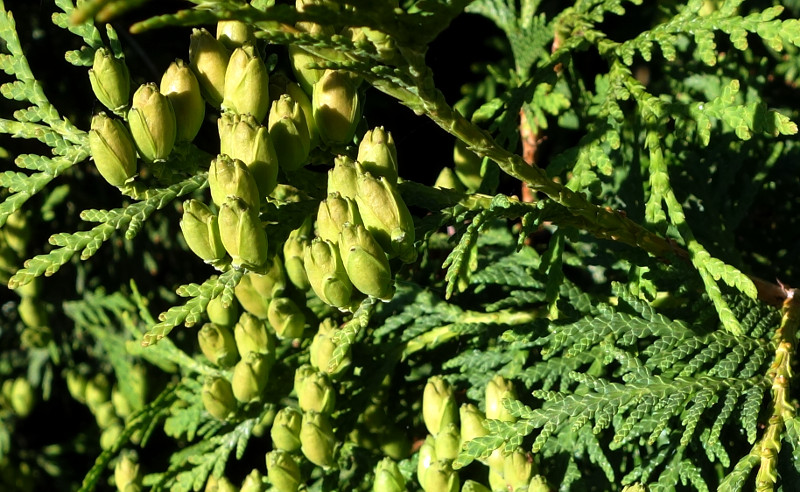Dies ist eine alte Version des Dokuments!
Thuja occidentalis L. - Cypressaceae
Eastern white cedar, white cedar, arborvitae, Abendländischer Lebensbaum
Evergreen tree, up to 20m high; native to eastern North America, cultivated and naturalized in the temperate regions of the northern hemisphere; twigs above deep green, underneath pale green; fruits small, green, cone-shaped.
„White Cedar is a tree with important uses in traditional Ojibwe culture. Honoured with the name Nookomis Giizhik („Grandmother Cedar“), the tree is the subject of sacred legends and is considered a gift to humanity for its myriad uses, among them crafts, construction and medicine… T. occidentalis is widely used as an ornamental tree, particularly for screens and hedges, in gardens, parks and cemeteries.“
http://en.wikipedia.org/wiki/Thuja_occidentalis
„The complete analysis of the neutral volatile oil of the leaves of Eastern white cedar (Thujaoccidentalis L.) by means of gas–liquid chromatography was attempted. The mixture of terpenes was resolved into 28 monoterpenoid components and the major ones were isolated in 5- to 20-mg amounts. Comparison of infrared spectra and retention times with those of authentic specimens led to the positive identification of d-α-pinene, camphene, sabinene, d-limonene, p-cymene, γ-terpinene, l-fenchone, l-α-thujone, d-isothujone, camphor, and bornyl acetate. α-Thujene, β-pinene, myrcene, 1,8-cineole, terpinolene, and terpinen-4-ol were tentatively identified. The percentage composition of a commercial sample of the oil and of one obtained from a tree grown in Saskatoon was determined. The latter oil contained 7.0 to 7.5% of sesquiterpenoid components, which were resolved into four peaks on polyester columns at 180 °C.“
[„Gas-liquid chromatography of Terpenes: Part IV. The analysis of the volatile oil of the leaves of Eastern white cedar.“ Rudloff, E. von., Canadian Journal of Chemistry, Vol.39(6), 1961, 1200-1206]
„The essential oil of the fresh leaves (related to the monoterpene fraction) contains 65% thujone, 8% isothujone, 8% fenchone, 5% sabinene and 2% α-pinene as the main monoterpenes… According to the European Agency for the Evaluation of Medicinal Products (EMEA), the content of thujone in dried twigs was determined as 7.6 mg/g, consisting of 85% α-thujone and 15% β-thujone…
A critical factor for Thuja’s use as a medicinal herb is its content of essential oil. Indeed, the content of thujone seems to be significantly affected by different extraction procedures. The highest content of essential oil was found in extracts obtained by distillation, whilst percolation with purified water
reduced the thujone content in the extract to the lowest level.“
[Thuja occidentalis (Arbor vitae): a review of its pharmaceutical, pharmacological and clinical properties. Naser, B., Bodinet, C., Tegtmeier, M., Lindequist, U., Evidence-based complementary and alternative medicine, 2(1), 2005, 69-78] http://downloads.hindawi.com/journals/ecam/2005/437374.pdf

